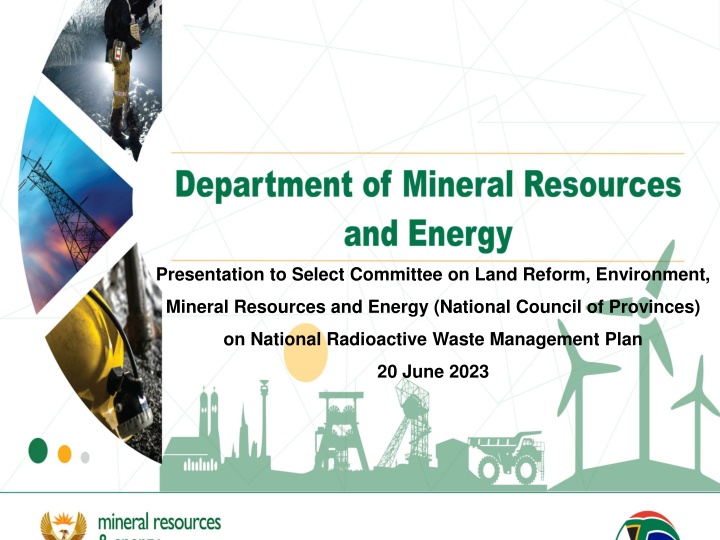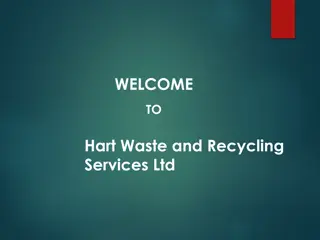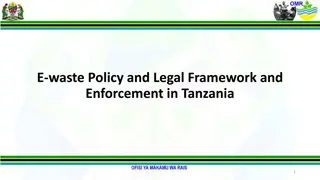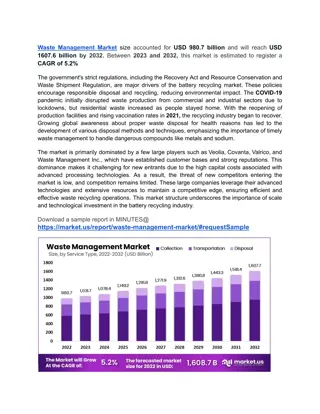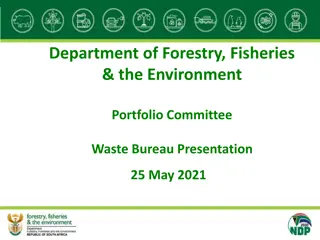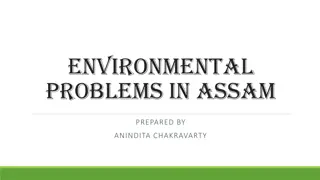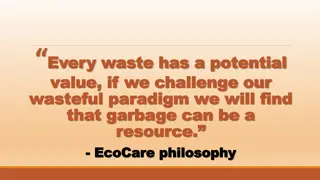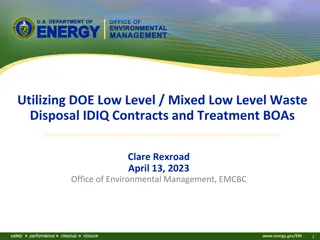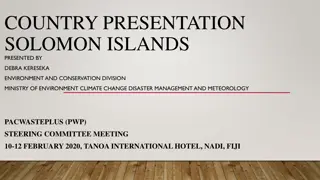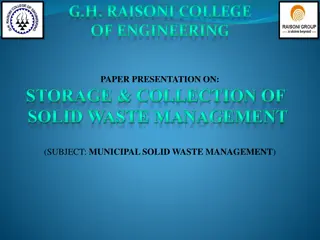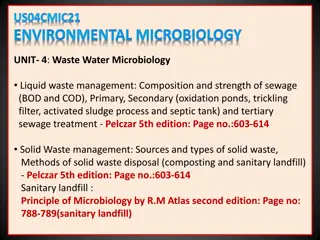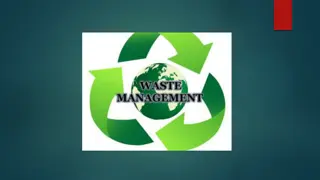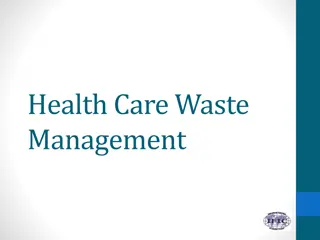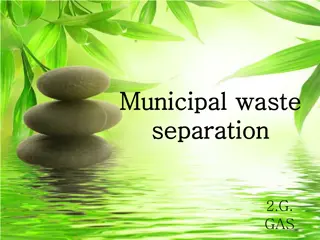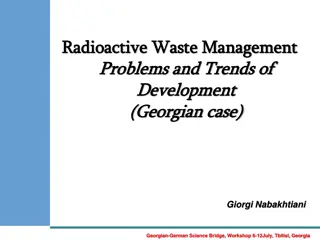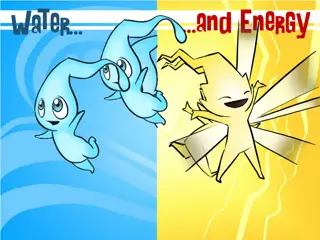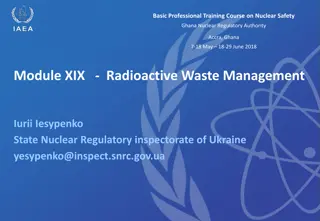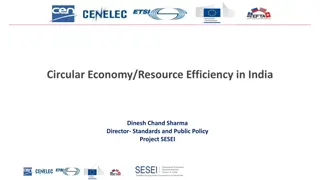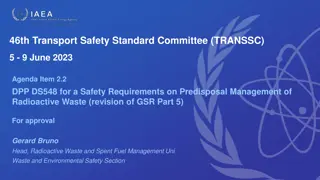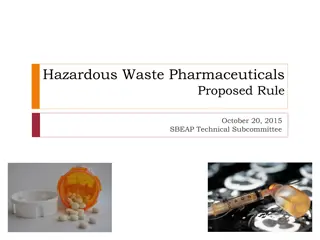National Radioactive Waste Management Plan Overview
Briefing the Select Committee on Land Reform, Environment, Mineral Resources, and Energy about the South African Radioactive Waste Management Programme and the legislative background governing radioactive waste management. The presentation outlines the framework, guiding elements, waste management plans, and outlook of the waste management program, emphasizing compliance requirements for waste generators. It also discusses the National Radioactive Waste Management Policy, the Nuclear Energy Act of 1999, and the establishment of key entities such as the National Radioactive Waste Disposal Institute. The role of the Minister of Mineral Resources and Energy in evaluating, recommending, and approving waste management plans, along with funding sources and consultation processes, are highlighted.
Download Presentation

Please find below an Image/Link to download the presentation.
The content on the website is provided AS IS for your information and personal use only. It may not be sold, licensed, or shared on other websites without obtaining consent from the author.If you encounter any issues during the download, it is possible that the publisher has removed the file from their server.
You are allowed to download the files provided on this website for personal or commercial use, subject to the condition that they are used lawfully. All files are the property of their respective owners.
The content on the website is provided AS IS for your information and personal use only. It may not be sold, licensed, or shared on other websites without obtaining consent from the author.
E N D
Presentation Transcript
Presentation to Select Committee on Land Reform, Environment, Mineral Resources and Energy (National Council of Provinces) on National Radioactive Waste Management Plan 20 June 2023
Presentation Outline Purpose Legislative Background Radioactive Waste Management Framework Guiding Elements for Waste Management Plans Waste Management Plans Outlook of waste management programme Conclude and Recommendation
Purpose To brief the Select Committee about the South African Radioactive Waste Management Programme; and Strategies and To request to the Select Committee note the South African Radioactive Waste overview and requirements of Waste Management Plans for compliance by radioactive waste generators. Management Policy
Legislative background Nuclear Energy Act, 1999 Section 45(1) The authority over the management and discarding of radioactive waste and the storage of irradiated nuclear fuel vests in the Minister. Section 46(1) Except where authorised by a ministerial authority issued under the Hazardous Substances Act, 1973 (Act No. 15 of 1973), no person may, without the written permission of the Minister, discard radioactive waste in any manner or cause it to be so discarded. Section 46(2) Except with the written permission of the Minister, no person may store any irradiated nuclear fuel or cause it to be stored.
Legislative background, Continued National Radioactive Waste Management Policy and Strategy of 2005 recommended for the establishment of the following: i) National Committee on Radioactive Waste Management (NCRWM); ii) National Radioactive Waste Disposal Institute (NRWDI); iii) Waste Management Fund, through the statutes. National Radioactive Waste Disposal Institute Act (Act 53 of 2008) Established the National Radioactive Waste Disposal Institute (NRWDI). NRWDI fulfils the Minister s responsibilities as set out in section 45(1) of the Nuclear Energy Act 46 of 1999 Manages radioactive waste disposal on a national basis. The Institute will amongst others source its funds from the polluter pays principle in order to effectively execute its mandate without hindrance.
Radioactive Waste Management Framework Minister of Mineral Resources and Energy and Energy and Energy Minister of Mineral Resources Mineral Resources Minister of Other Sources of Funds Other Sources of Funds Other Sources of Funds evaluates & recommends plans plans plans evaluates & recommends recommends evaluates & approves plans plans plans approves approves (loans, donations, sales etc.) (loans, donations, sales etc.) (loans, donations, sales etc.) consults consults consults National RWM Committee Committee Committee National RWM National RWM National RWM Fund Fund Fund National RWM National RWM requests for funds requests for funds requests for funds (NNR, DMRE, DOH, DEFF, DWS and NNR) DEFF, DWS and NNR) DEFF, DWS and NNR) (NNR, DMRE, DOH, (NNR, DMRE, DOH, contributes funds allocates funds funds funds contributes funds contributes funds contributes funds contributes funds allocates allocates (c/kWh / Rm3) (c/kWh / Rm3) (c/kWh / Rm3) (levies) (levies) (levies) (levies) (levies) submits submits submits plans plans plans pays user-charges pays user-charges pays user-charges Disposal Institute Institute Institute Disposal Disposal Disposal Site Consists of facilities for: storage encapsulation disposal disposal disposal Disposal Site Consists of facilities for: storage encapsulation encapsulation Disposal Site Consists of facilities for: storage Waste Generator On-site waste collection treatment packaging storage transportation plans plans plans Waste Generator On-site waste collection treatment packaging storage Waste Generator On-site waste collection treatment packaging storage transportation transportation sites, constructs, operates, decomms facilities facilities facilities sites, constructs, operates, decomms decomms sites, constructs, operates, WAC development siting R&D storage encapsulation disposal monitoring execution of plans execution of plans execution of plans WAC development siting R&D storage encapsulation disposal monitoring monitoring WAC development siting R&D storage encapsulation disposal delivers waste delivers waste delivers waste
Radioactive Waste Management Framework National Radioactive Waste Management Model The radioactive waste management process (1) Radioactive Waste Generation potential radioactive waste generated through regulated activities. (2) Pre-disposal Management of Radioactive Waste to ensure waste minimization, selection of suitable waste management options (BATNEEC), waste package to amongst others meet Waste Acceptance Criterion (WAC). (3) Radioactive Waste management options Including Regulated storage and disposal. (4) Radioactive Waste management end-points requires continued regulation of the disposal site for a predetermined duration where after the site shall be placed under institutional control.
Guiding Elements for Waste Management Plans Radioactive Waste Management Programme: The establishment of NRWDI to undertake waste disposal function institutional obligation in terms of Section 55 (2) of the Nuclear Energy Act, 1999. Establishment of the National Committee on Radioactive Waste Management to provide strategic guidance on waste management issues and advise Minister of Mineral Resources and Energy including on approvals of waste management plans. The Committee comprises of regulatory Departments that are independent from waste generators such as DEFF, NNR, DWS and DOH/SAPHRA.
Guiding Elements for Waste Management Plans Understanding of Roles and Responsibilities of Stakeholders. DMRE/Minister development of legislation, policy and the monitoring of the implementation thereof. Regulatory bodies to work in a co-operative manner and be responsible to enforce compliance with legal requirements (Viz: NNR, DFFE, NNR and SAPHRA). Waste Generators & operators to manage radioactive waste within the national regulatory framework; development and review of WMPs based on principles such as BATNEEC amongst others.
Guiding Elements for Waste Management Plans Definition and Classification of radioactive waste The importance of IAEA guidelines in the definition and classification of radioactive waste. Any deviations can be justified. Definition (Nuclear Energy Act, 1999) radioactive waste means any radioactive material destined to be disposed of as waste material. Potential radioactive waste for example, Used Nuclear Fuel.
Guiding Elements for Waste Management Plans Financial Provision for Radioactive Waste Application of polluterpays principle. Establishment of the Radioactive Waste Management Fund for the long-term management options of the various waste forms e.g. disposal fees, R&D for waste management/disposal options. The existing interim arrangements waste disposal contracts, conditioning of Disused radioactive sources (DSRS).
Waste Management Plans Based on the national radioactive waste management framework, the radioactive waste generators within the nuclear industry develop Radioactive Waste Management Plans (RWMPs), in consultation with National Radioactive Waste (NRWDI), as required. Disposal Institute The recommendation of the National Committee on Radioactive Waste Management (NCRWM), in terms of the Radioactive Waste Management Policy & Strategy (2005). RWMPs are approved by Minister on
Waste Management Plans The DMRE monitors the implementation of the RWMPs by waste generators through the NCRWM. The outcome thereof informs the policy factors to be considered to ensure that the Minister s institutional obligations on radioactive waste management in terms of the Nuclear Energy Act, 1999, is fulfilled effectively. Based on the evaluation of these policy elements, the measures are taken by the Department to improve the national radioactive framework. waste management
Waste Management Plans South Africa commissioned international peer review Missions through the International Atomic Energy Agency (IAEA), such as the Integrated Regulatory Review Service Mission (IRRS) and Integrated Nuclear Infrastructure Mission (INIR) that informs policy development such as: The Decommissioning Policy and a National Backend Strategy. These policy initiatives are currently at the development phase and are being consulted with relevant stakeholders. Department is currently developing a The Department s strategic plans on radioactive waste management is to exercise oversight on implementation such policy initiatives, in order to improve the effectiveness of the South African waste management programme.
Outlook of waste management programme Current status Two long-term radioactive waste management options are (1) Above ground disposal in engineered facilities for the bulk of the mining waste, (2) Near surface disposal for Low and Intermediate Level Waste at Vaalputs. The High-Level Waste is currently stored onsite by waste generators. The inventories published in the Join Convention Reports of South Africa.
Outlook of waste management programme Future Outlook Key functions of NRWDI in terms of section 5 of the NRWDI Act 53 of 2008 are: Define and conduct research and development aimed at finding solutions for long-term radioactive waste management and disposal. Site, design and construct new disposal and related facilities as required. NRWDI is currently focussing on providing solutions for the long-term management and disposal of Spent Nuclear fuel such as Central Interim Storage Facility (CISF) and Deep Geological Repository (DGR).
Outlook of waste management programme Long-term waste management One site shall be developed for each of the waste classes (excluding NORM waste, which is disposed of on site in bulk). This is to maximize benefits from economies of scale for all activities associated with disposal waste management In 2018, the Minister authorised NRWDI to establish the Centralised Interim Storage Facility by 2030. Vaalputs shall continue to be used as a National Disposal Site for Low and Intermediate Level Waste DMRE continues to monitor progress and provide guidance on NRWDI license application process to operate Vaalputs.
Outlook of waste management programme Long-term waste management The Government shall initiate investigations into the best long-term option for the management of Used Fuel The DMRE is developing the National Backend Strategy, and to ensure coordination and phased approach in the implemented solutions such as the TISF, CISF, and DGR. The Government shall establish a radioactive waste management fund to ensure that there are sufficient provisions for the long-term management options of the various waste forms The DMRE has developed the Radioactive Waste Management Fund Bill (RWMFB) to address the funding arrangements for the disposal of radioactive waste. Public comments are being addressed prior to submission of the Bill to Cabinet to seek approval be tabled in Parliament
Conclusion and Recommendation It is recommended that the Select Committee: Notes that South Africa has well established Radioactive Waste Management Framework and waste is safely managed Notes that the Radioactive Waste Management Framework is being improved through policy and strategy enhancement based IAEA Missions conducted in the recent past. Notes that Government continues to exercise oversight on the implementation of the Radioactive Waste Management Plans, and the monitoring thereof through NCRWM led by DMRE. Notes that both waste generators such as Eskom and Necsa have submitted their overarching Management Plans to the Department for Ministerial approval Radioactive Waste
